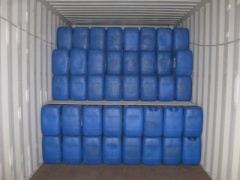Acetic Acid
| Infobox on Acetic Acid | |
|---|---|
| Example of Acetic Acid |  |
| Facts | |
| Origin | - |
| Stowage factor (in m3/t) | Barrels: 1,53m3/t, 54 ft3/t |
| Humidity / moisture | Moisture, %≤0.15 |
| Ventilation | See text |
| Risk factors | IMDG Class 8 Corrosive, also flammable |
Acetic Acid
Description
A colourless liquid normally carried in glass or plastic carboys in an outer packing of box, drum or hamper, also in metal or plastic drums. Miscible with water. Becomes flammable when containing more than 80% acid by weight.
A combustible liquid when heated. Corrosive to lead and most other metals. Strong irritant to skin. Odour may taint other cargoes. At low temperatures is likely to turn cloudy with no detrimental effect. Distortion of, and leakage from containers may be caused by expansion of contents due to rise in temperature. Aluminium containers with bung screw caps are liable to breakage at seams. Wooden casks are not suitable for long voyages due to possible corrosion and disintegration of hoops.
Glacial Acetic Acid is the pure compound and crystallizes at temperatures below 16°C without ill effect of the product. When frozen may move freely and cause breakage with consequent leakage on reliquefying. See also Acids.
Property
Clear and colorless liquid, with a pungent odor, miscible with water, ethanol, glycerin and aether but not with carbon bisulfide. Specific gravity: 1.04928; Melting point: 16.665 0.002 C; Boiling point: 117.9 C; Viscosity: 1.22 centipois (20 C); Flash point: 43 C (closed cup); Refractive index: 1.3715; Burning point: 465 C. Frozen into ice at a temperature of less than 16 C.
Shipment/storage/usage
Acetic acid is an organic compound with the chemical formula CH3COOH. It is a colourless liquid that when undiluted is also called glacial acetic acid. It is a cigarette additive and, as the main component of vinegar, has a distinctive sour taste and pungent smell. Although it is classified as a weak acid, acetic acid is highly dangerous to skin.
Acetic acid is one of the simplest carboxylic acids. It is an important chemical reagent and industrial chemical, mainly used in the production of cellulose acetate mainly for photographic film and polyvinyl acetate for wood glue, as well as synthetic fibres and fabrics. In households, diluted acetic acid is often used in descaling agents. In the food industry, acetic acid is used under the food additive code E260 as an acidity regulator and as a condiment.
Usage
As one of most important organic raw materials, it is mainly used in such products as Vinyl acetate, acetic anhydride, diketene, acetate ester, acetate, acetate fiber and chloroactic acid etc. It is an important raw material for synthesized fiber, gooey, medicines, pesticides and dyes, and also a good organic solvent. It is widely applied in such industries as of plastics, rubbers and printing etc.
Packing, transportation and storage
In accordance with relevant regulations in GE, 190 and GB/T 10479, it is transported in the dedicated SS or Al tank truck, or SS shipping tank or plastic barrel. The packing capacity of the plastic barrel is 25 kg, 50 kg or 200 kg.
The packing container shall be clean and dry, and shall be gently handled to prevent any collision during transportation and loading/unloading.
It should be stored in a cool, well-ventilated and dry place, away from solarization, flame source and heat source; And should not be stored together with alkali substances.
Risk factors
IMDG Class 8 Corrosive, also flammable
Moderate fire risk. Pure acetic acid is moderately toxic by ingestion and inhalation, but dilute material is approved by FDA for food use. Strong irritant to skin and tissue. TLV: 10 ppm in air.











